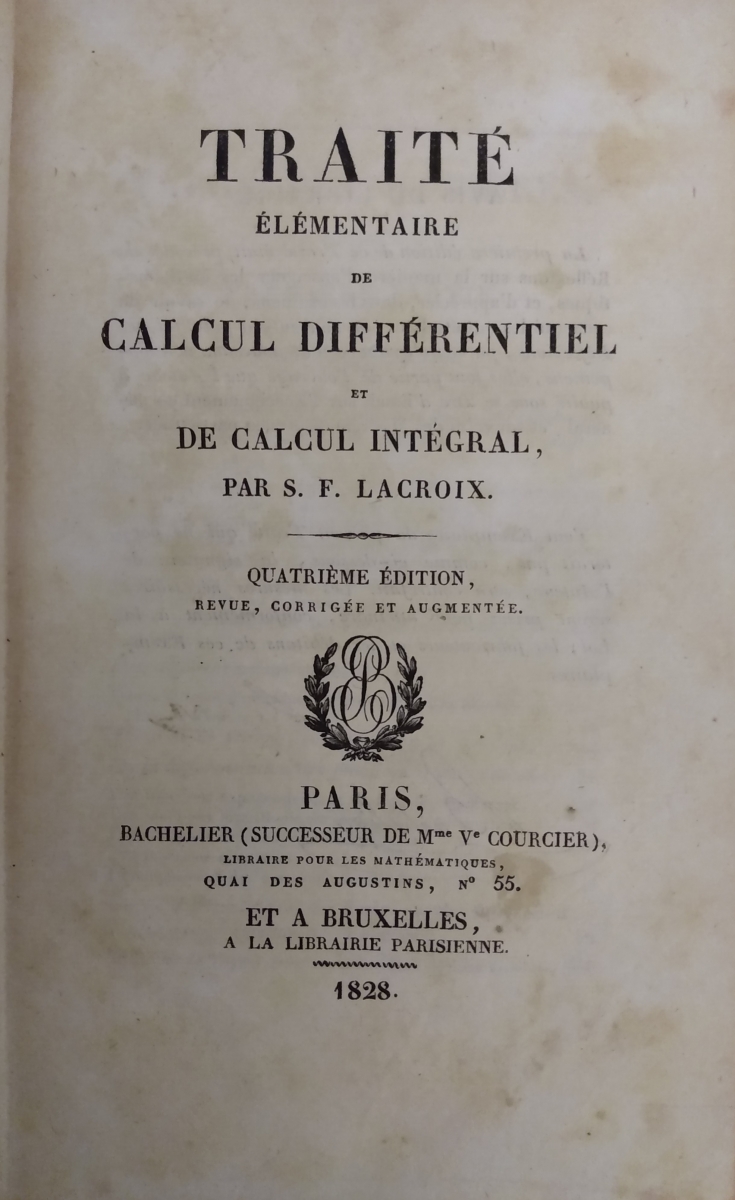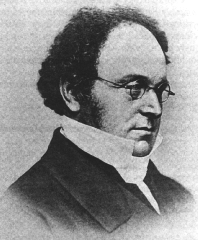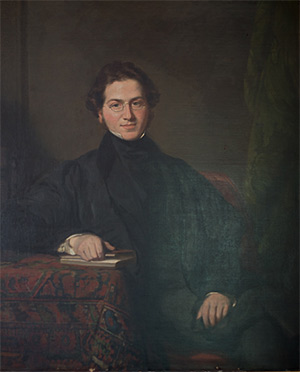A Mysterious Copy of Lacroix’s Traité Élémentaire de Calcul Différentiel et de Calcul Intégral: A Mathematical Treasure
Sylvestre François Lacroix (1765–1843) was a prolific and highly successful author of mathematical textbooks in the late 18th and early 19th centuries. One of his most significant publications was the 1790-page Traité du Calcul Différentiel et du Calcul Intégral (Treatise on Differential Calculus and Integral Calculus), published in three volumes between 1797 and 1800. In 1802 Lacroix, by then a professor at the École Polytechnique in Paris, published an abridged version in a single volume, entitled Traité Élémentaire de Calcul Différentiel et de Calcul Intégral (Elementary Treatise of Differential Calculus and Integral Calculus). The three parts of the shorter book, on differential calculus, integral calculus, and differences and series, corresponded to the respective contents of the three volumes of the original work. Its main goal was “to make the 18th-century calculus, in all its details, much more easily accessible and fruitful to the 19th-century mathematicians” [Domingues 2005, p. 291].

Figure 1. Title page of Lacroix's textbook. All photographs of
Lacroix’s Traité Élémentaire de Calcul Différentiel et de Calcul Intégral
that appear in this article depict the author’s copy and were taken by the author.
Like many of Lacroix’s other textbooks, the Traité Élémentaire was very successful, going through nine editions between 1802 and 1881, and receiving English, German, Italian, and Portuguese translations within the first few decades of its initial publication. Of course, it was the English translation of 1816, published by Charles Babbage, John Herschel and George Peacock, that would have the most celebrated impact, as it helped introduce the European differential and functional notation to a British audience, in preference to the old Newtonian fluxional symbols that by then had become a barrier to mathematical discourse between British mathematicians and their continental counterparts.

Figure 2. Front cover of author's copy of Lacroix's textbook.
The pictures above are of my copy of the 4th edition from 1828. As will become clear, the date of this edition is significant to our story. It was clearly brand new when it received its very attractive leather binding, featuring the insignia of the “University of London” along with its date of foundation: “1827.” The university was in fact founded in 1826 as the “London University,” retaining this title until it received its current name, University College London (UCL), in 1836. At the time of its foundation, it was the first such institution to have been established in England since Oxford and Cambridge in the Middle Ages, and it attracted controversy for its liberal admissions policy under which non-Anglicans were permitted a university-level education for the first time in England.
A Mysterious Copy of Lacroix’s Traité Élémentaire de Calcul Différentiel et de Calcul Intégral: De Morgan and Sylvester at the University of London

Figure 3. Engraving of University College London’s main building (1828). Wikimedia Commons.
The University of London's first professor of mathematics was Augustus De Morgan (1806–1871), who was appointed in 1828, scarcely a year after graduating from Cambridge [Rice 1997]. Not surprisingly, the level of mathematics taught by De Morgan in those early years was very different, bearing a closer resemblance to high school mathematics than today’s undergraduate courses [Rice 1999]. His students were divided into ‘junior’ and ‘senior’ classes, with each group of students having a ‘higher’ and ‘lower’ division, based on ability. While the lower junior class worked on basic algebra and the first book of Euclid’s Elements, it was not until the higher senior class that students would be exposed to rigorous differential and integral calculus. When the University of London opened for its first lectures in November 1828, De Morgan’s higher senior class consisted of only three or four students—but it included one of the most talented mathematicians De Morgan would ever teach.


Figure 4. (Left) Augustus De Morgan. Convergence Portrait Gallery. (Right) James Joseph Sylvester.
Image of 1841 oil painting by George Patten, in private possession, courtesy of Alain Enthoven.
James Joseph Sylvester (1814-1897) would eventually become one of the foremost British mathematicians of the 19th century and was to contribute to the advancement of the subject in several areas, particularly linear algebra [Parshall 2006]. Born in London to a prosperous middle class Jewish family, he was admitted as a student of the university in November 1828, aged just fourteen. He immediately entered the higher division of De Morgan's senior class “and became by far the first pupil in it” [Anonymous 1837, f.3], distinguishing himself “by the facility with which he acquired a knowledge of the higher branches of Mathematics & the singularity of his power to apply them” [De Morgan 1841]. Indeed, so impressed was De Morgan by his remarkable young student that he later went on record to say “that he never, before or since, saw mathematical talent so strongly marked in a boy of that age” [Anonymous 1837, f.3].
However, outstanding though his mathematical talents undoubtedly were, Sylvester's general demeanor left much to be desired. Reports sent to his sister (in whose care he was at the time) concerning his conduct and attendance complained “of his inattention to his duties” [E. J. Sylvester, 9 Feb. 1829]. He was also apparently “of a most impetuous and irritable disposition, and his extreme youth, together with his religion, reputation for talent, and the disposition above-mentioned, made him, it is supposed, a mark for the practical jokes of his fellow students” [Anonymous 1837, f.4]. A consequence of this taunting, combined with the boy's volatile temper, led to the display of “so great a disposition to an act of violence that his friends were advised by the authorities of the College to remove him: which was accordingly done” [Anonymous 1837, f.4].
A clue to what form this violent behavior took lies in an extract from a letter, formerly in the archives of UCL, which stated that: “The accompanying knife has just been taken from young Sylvester, who had brought it from the Refreshment rooms for the purpose of stabbing Mr. Tulk.”[1] This event led to the myth that Sylvester was one of the first students to be expelled from the university. But a letter from his sister, written at the end of February 1829, reveals Sylvester's family had already concluded that “owing to the extreme youth of my Brother and the fact of his requiring constant control and attention they deem it advisable that he should for the present withdraw from the London University” [E. J. Sylvester, 25 Feb. 1829]. He was to return eight years later under very different circumstances, as UCL’s Professor of Natural Philosophy. But despite the brevity of his studies in London, he remained proud of the four months he had spent under the tutelage of De Morgan, “whose pupil,” he later recalled, “I may boast to have been” [J. J. Sylvester 1840, p. 43].
[1] This letter is now missing from the archives, but the card catalogue preserves this extract.
A Mysterious Copy of Lacroix’s Traité Élémentaire de Calcul Différentiel et de Calcul Intégral: Signed by De Morgan
What then does this story have to do with my copy of the 4th edition of Lacroix’s Traité Élémentaire de Calcul Différentiel et de Calcul Intégral? The answer is contained on a bookplate, pasted inside the book’s front cover. Bearing the heading “University of London”, it proclaims that
At the Examination of Students held
at the conclusion of the Session 18___
This Book was awarded to __________
of _____________________________
being the _________ Prize in the Class
of ______________________________.
All the necessary details have been left blank—but it does bear the signature of the Professor: Augustus De Morgan. It is thus clear that my copy of the Traité Élémentaire by Lacroix was intended as a prize for one of De Morgan’s classes, but that it was never awarded.

Figure 5. Bookplate in author’s copy of Lacroix’s textbook.
In its earliest years, UCL—in its initial incarnation as the University of London—could not award degrees. Instead, at the end of each year, students in each subject would take exams and, if they were successful, would receive a “Certificate of Honor”. The very best performing students would also receive a prize, in the form of a book or, occasionally, a medal. However, in its first session of operation, namely 1828–1829, student ability and preparation were not perhaps as high as De Morgan and his colleagues might have wished. For example, in the lower division of his senior class, only four out of the nine who entered for the exam obtained certificates. And after Sylvester’s withdrawal, the number of students capable of following the material in the higher senior class must have been almost negligible since at the close of the session, De Morgan reported that “the very small number of them who have made this progress, and the departure of some of them from the University, have made an examination of this division of the [senior] Class impracticable” [Anonymous 1829, p. 6]. As a result, no prize was given that year in his higher senior class.
Things did improve, however, and by the close of the 1829–1830 academic year, De Morgan could report that “the state of preparation of the generality of Students, at the commencement of the present Session, was much superior to that of the last” [Anonymous 1830, p. 32]. Consequently in that and subsequent years, prizes were awarded for all divisions of De Morgan’s mathematics classes. Yet for reasons unknown, the copy of Lacroix remained unclaimed. Perhaps the year of publication on its title page, 1828, possibly chosen as fitting for the inaugural year of the institution, was quickly viewed as out of date. Perhaps other more recent calculus textbooks (or the English translation of Lacroix) were viewed as better awards for deserving students. Whatever the case, the book was clearly forgotten, changing hands over time until, one day in the late 1990s, I bought it from a retiring professor and came face-to-face with De Morgan’s signature and a mystery that intrigues me to this day.
So is this book a remnant from a prize ceremony that took place during UCL’s first year of operation nearly 200 years ago? Could it have been intended originally for the young J. J. Sylvester? And was his premature departure from UCL the reason that this prize was never awarded and, ultimately, that the book ended up in my collection instead of his?
We shall never know.
A Mysterious Copy of Lacroix’s Traité Élémentaire de Calcul Différentiel et de Calcul Intégral: References
Anonymous. 1829. University of London. Distribution of the Prizes and of the Certificates of Honours ... Session 1828–1829. London: John Taylor.
Anonymous. 1830. University of London. Distribution of the Prizes and of the Certificates of Honours ... Session 1829–1830. London: John Taylor.
Anonymous. 1837. Committee Report on the appointment to the chair of natural philosophy, 18 Nov. 1837, College Correspondence, No. AM/7. UCL Special Collections.
De Morgan, Augustus. 1841. Testimonial for J. J. Sylvester, [May 1841], College Correspondence. UCL Special Collections.
Domingues, João Caramalho. 2005. S. F. Lacroix, Traité du Calcul Différentiel et du Calcul Intégral, First Edition (1797–1800). In Landmark Writings in Western Mathematics 1640–1940, edited by I. Grattan-Guinness, 277–291. Amsterdam: Elsevier.
Lacroix, S. F. 1828. Traité élémentaire de calcul différentiel et de calcul intégral. 4th ed. Paris: Bachelier.
Parshall, Karen Hunger. 2006. James Joseph Sylvester: Jewish Mathematician in a Victorian World. Baltimore: Johns Hopkins University Press.
Rice, Adrian. 1997. Inspiration or desperation? Augustus De Morgan’s appointment to the Chair of Mathematics at London University in 1828. British Journal for the History of Science 30: 257–274.
Rice, Adrian. 1999. What Makes a Great Mathematics Teacher? The Case of Augustus De Morgan. The American Mathematical Monthly 106(6): 534–552.
Sylvester, E. J. 1829, February 9. Letter from E. J. Sylvester. College Correspondence, No. 1614. UCL Special Collections.
Sylvester, E. J. 1829, February 25. Letter from E. J. Sylvester. College Correspondence, No. 1615. UCL Special Collections.
Sylvester, James Joseph. 1840. On Derivation of Coexistence, Part II. Being the theory of simultaneous simple homogeneous equations. Philosophical Magazine, 3rd ser., 16(100): 37–43.
A Mysterious Copy of Lacroix’s Traité Élémentaire de Calcul Différentiel et de Calcul Intégral: About the Author
Adrian Rice is the Dorothy and Muscoe Garnett Professor of Mathematics at Randolph-Macon College in Ashland, Virginia, USA. His research focuses on the history of mathematics, specifically the development of algebra, analysis and logic in 19th- and early 20th-century Britain. He has received several awards for outstanding expository writing, most recently in 2022, when he was a co-recipient of a George Pólya Award from the MAA for the 2021 article “Why Hamilton Couldn’t Multiply Triples,” co-authored with Ezra Brown.